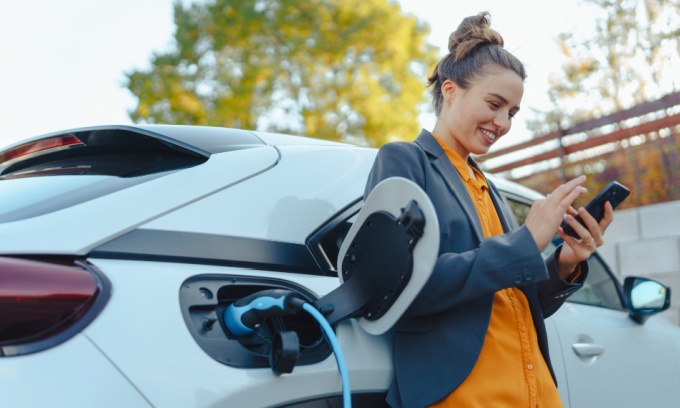The majority of ‘green’ vehicles sold in Australia aren’t fully electric cars. Instead, they’re hybrid (HEV) and plug-in hybrid electric vehicles (PHEV), which offer many of the eco-benefits and fuel savings as their fully electric counterparts, combined with the power that comes with a petrol engine.
More than 20 years after the Toyota Prius arrived locally in 2001, six of the top 10 highest selling conventional hybrid models in Australia are manufactured by Toyota. More broadly, hybrid and plug-in hybrid cars accounted for 17.1% of total new car sales in January 2025.
If you’re in the market for a fully electric vehicle (EV), you may like to compare car loans (or even green car loans), and car insurance, as well as the car insurance deals and offers which are currently available. If you’re looking at a more prestigious car brand, you may be interested in how the luxury car tax could affect you.
What is a hybrid car?
A hybrid car combines at least one electric motor with an engine that’s usually petrol, to deliver a vehicle that’s more environmentally sustainable than a car that only has a conventional internal combustion engine.
How do hybrid cars work?
In a conventional hybrid car, the system recaptures kinetic energy caused by the slowing of the vehicle, often referred to as regenerative braking. This charges the vehicle’s electric battery. The battery can also be charged via the internal combustion (petrol) engine. This battery can then be used to power one or more electric motors.
When driving, the petrol engine or the electric motor does most of the work, but sometimes they work together. The electric battery can also power on-board electrical components like heating, ventilation and lights, as well as reduce engine idling when stopped. Together, this can lead to less petrol consumption, without needing to sacrifice power and performance.
What is a plug-in hybrid car?
A plug-in hybrid electric vehicle is a car that is run primarily using a large, battery-powered electric motor that can be charged by plugging it into an electrical source. PHEVs do have a petrol or other internal combustion engine, but it’s only used when the battery power in the electric motor is depleted.
The larger battery and plug-in feature of a PHEV means that, unlike a HEV, it can operate solely on the power of the electric engine for around 40 to 60 kilometres (depending on the model). With less dependence on the petrol engine, a PHEV does not consume as much petrol or emit as much carbon dioxide (CO2) as a HEV. However, due to its larger and more expensive battery and potential need for charging accessories, a PHEV will typically cost more to purchase than a HEV.
Top 10 best selling hybrid cars in Australia
Keen to know what Australian hybrid car owners are driving? These are the top 10 highest selling hybrid cars in Australia, according to Drive.com:
Best selling conventional hybrid cars
← Mobile/tablet users, scroll sideways to view full table →
| Model | Number of sales |
|---|---|
| Toyota RAV4 | 55,902 |
| Toyota Corolla | 19,460 |
| Toyota Camry | 14,475 |
| Toyota Kluger | 8,212 |
| Toyota Corolla Cross | 7,727 |
| Toyota Yaris Cross | 5,266 |
| Hyundai Kona | 4,825 |
| GWM Haval H6 | 4,521 |
| Lexus NX | 4,417 |
| GWM Haval Jolion | 4,328 |
Source: Drive.com. The above data covers sales for the period of January 2024 till December 2024.
Best selling plug-in hybrid cars
← Mobile/tablet users, scroll sideways to view full table →
| Model | Number of sales |
|---|---|
| BYD Sealion 6 | 6,198 |
| Mitsubishi Outlander | 6,126 |
| Mitsubishi Eclipse Cross | 2,368 |
| Mazda CX-60 | 1,481 |
| MG HS | 882 |
| Volvo XC60 | 872 |
| Cupra Formentor | 598 |
| Porsche Cayenne | 490 |
| Lexus NX | 351 |
| Audi Q5 | 351 |
Source: Drive.com. The above data covers sales for the period of January 2024 till December 2024.
Compare car insurance policies
If you’re comparing car insurance policies, the comparison table below displays some of the policies currently available on Canstar for a 30-39 year old male seeking comprehensive cover in NSW without cover for an extra driver under 25. Please note the table is sorted by Canstar Star Rating (highest to lowest) followed by provider name (alphabetical) and features links direct to the providers’ websites. Consider the Product Disclosure Statement (PDS) and Target Market Determination (TMD), before making a purchase decision. Contact the product issuer directly for a copy of the PDS and TMD. Use Canstar's car insurance comparison selector to view a wider range of policies. Canstar may earn a fee for referrals
- Save 15%^ on your first year’s premium when you purchase a new Car Insurance policy online.
- 24/7 Phone & Online Claims.
- Budget Direct - Insurance Solved.
- Insurance that's a bit more you-shaped.
- Canstar's 2024 Most Satisfied Customers Car Insurance - National Award.
- Lodge a Claim 24/7 with our Advisors
- Flexible cover before, 24/7 claims after.
- Save $75 on new Comprehensive car insurance online.
- Conditions apply.
- Option To Pay Monthly. Save On Your Premium By
- Increasing Your Basic Excess (Within A Given Range)*
- Lodge A Claim Online 24/7
- No age-based excess.
- No excess on your first covered windscreen repair.
- Canstar 2025 Outstanding Value Car Insurance Award.
- Get up to $50 off a Coles shop every month with free Coles Plus Saver for 12 months when you take out a new Comp Car Policy & link your Flybuys. Offer ends 31.08.25.
- Choose base insurance or add on optional extras. Select from a range of excess options. Lifetime guarantee on repairs authorised by Bingle.
What are the ten best hybrid cars in Australia based on sales?
What the best hybrid car (either conventional or plug-in) is for you will depend on your personal preferences, needs and budget. Looking at the above sales data, here is Canstar’s list of the 10 best hybrid cars in Australia.
1. Toyota RAV4 Hybrid
- Price: From $46,732.
- What’s to love: Currently Australia’s best selling hybrid car, its standout feature is its ability to drive up to 40km/hr on the electric motor alone. It’s useful for city and suburban driving, while also providing impressive power and performance when using the petrol and electric motors simultaneously.
- Specs: Toyota RAV4 Hybrid.
2. Toyota Corolla Hybrid
- Price: From $36,083.
- What’s to love: Another trusted and reliable Toyota hybrid comes in the form of the Corolla. Connecting a 1.8-litre engine to an electric motor provides an efficient drivetrain (a group of components that deliver mechanical power), coupled with a solid build and responsiveness, the Corolla won’t leave you feeling short-changed.
- Specs: Toyota Corolla Hatch; Toyota Corolla Sedan.
3. Toyota Camry Hybrid
- Price: From $44,393.
- What’s to love: Like the models before it, the Toyota Camry Hybrid brings the benefits of electric and petrol together in a hybrid alternative that leverages the Camry’s position as one of Australia’s favourite medium-sized sedans.
- Specs: Toyota Camry Hybrid.
4. Toyota Kluger Hybrid
- Price: From $66,311.
- What’s to love: A spacious seven seater, the Toyota Kluger Hybrid combines impressive fuel efficiency for its vehicle class (5.6L/100km) with a 2.5L petrol engine and electric motors for smooth acceleration. The Kluger also comes equipped with pre-collision warning systems and adaptive cruise control.
- Specs: Toyota Kluger Hybrid.
5. Toyota Corolla Cross Hybrid
- Price: From $40,582.
- What’s to love: Delivering a combined fuel consumption of as low as 4.2L/100km in the GX 2WD variant, the Toyota Corolla Cross Hybrid offers practical cargo space, a comfortable interior and a host of safety features such as multiple airbags, lane-keeping assistance and blind-spot monitoring.
- Specs: Toyota Corolla Cross Hybrid.
6. BYD Sealion 6 PHEV
- Price: From $42,990.
- What’s to love: Australia’s most popular PHEV, the BYD Sealion 6 offers up to 92km worth of driving using the electric battery alone. The Sealion 6 is also one of the more affordable plug-in hybrid options available on the Australian market.
- Specs: BYD Sealion 6.
7. Mitsubishi Outlander PHEV
- Price: From $62,310.
- What’s to love: This model is one of Australia’s top selling plug-in hybrid vehicles (PHEVs). A previous model of the Outlander won the prestigious ‘Good Design’ Award in its home country of Japan even before arriving in Australia. The awards reflect Japan’s “sole official design evaluation and awards program”, according to Drive.
- Specs: Mitsubishi Outlander.
8. Toyota Yaris Cross Hybrid
- Price: From $34,834.
- What’s to love: The Toyota Yaris Cross Hybrid is one of two hybrids in the light car category for the Australasian New Car Assessment Program (ANCAP), but it’s the only one to have been awarded the coveted five-star safety rating. It also benefits from 10 years of hybrid battery cover. With a tight turning circle, it’s perfect for navigating narrow inner-city parking.
- Specs: Toyota Yaris Cross.
9. Hyundai Kona Hybrid
- Price: From $40,705.
- What’s to love: Delivering a compact SUV that makes maneuvering and parking in tight city spaces easier, the Hyundai Kona Hybrid provides a smooth and quiet driving experience alongside an effective drivetrain.
- Specs: Hyundai Kona Hybrid.
10. GWM Haval H6 Hybrid
- Price: From $30,990.
- What’s to love: Providing ample room for both passengers and cargo, the GWM Haval H6 Hybrid boasts a sleek exterior, contemporary interior and an efficient hybrid system.
- Specs: GWM Haval H6 Hybrid.
Pricing for Canstar’s top 10 best hybrid cars in Australia list is based on driveaway prices at the time of writing for the 2000 (Sydney) post code. Unless otherwise stated, the prices are for the base hybrid model of each car. The total price you pay will likely be somewhat higher and may vary depending on where in Australia you live, as well as the variant and specifications you choose. Keep in mind Canstar has brought this list together based on sales data alone. There may be another hybrid electric car, or a different car altogether, that’s better suited for you and your needs.
Hybrid vs electric vehicles: what’s the difference?
Unlike a hybrid or plug-in hybrid electric car, a pure electric vehicle has no petrol engine and is powered solely by a battery engine that can be charged by plugging into an electrical source. An electric car emits no CO2 from the vehicle and can help a driver save even more on fuel costs. However, with no petrol engine to fall back on, an electric car may be more limited in how far it can be driven before needing to be recharged. It’s also typically more expensive to purchase than a hybrid or plug-in hybrid electric vehicle.
Related: How much does it cost to run an electric car?
What are the benefits of a hybrid car?
Hybrid car benefits can include reduced running costs, lower tailpipe emissions, a quieter and smoother driving experience, as well as stronger performance. CarsGuide explains it well: “the combination of an internal combustion engine and an electric motor adds extra power and enhanced performance to a hybrid, since electric motors require zero revs to achieve maximum torque”.
5 factors in choosing a hybrid car
If you are looking to make a switch from a pure petrol or diesel model to a low-emission hybrid or plug-in hybrid vehicle, five factors to consider are:
1. Cost
Although there are some relatively cheap hybrid vehicles available in Australia, most are generally more expensive than their equivalently-sized petrol-engined counterparts. This is due to the added cost and complexity of the battery pack, electric motor, unique transmission and generator technology.
However, pricing for these cars has come down significantly in recent years, with hybrids now becoming a viable alternative for consumers. It’s important to consider whether the added upfront price can be made up by the savings you can make on petrol. Since there are two propulsion systems in HEVs and PHEVs (petrol and electric), this can also add to the cost and complexity of servicing and repairing these cars.
When it comes to plug-in hybrids, the upfront cost of one of these types of cars is often substantially more than its petrol and HEV counterparts. In some states there are registration and stamp duty incentives available for low-emission vehicles such as HEVs and PHEVs, which may help the drivers of these cars save money. If you’re looking for a loan to buy your new hybrid car, some lenders offer specialised green car loans for eco-friendly vehicles, often with a better interest rate. You can compare green car loans with Canstar.
2. Greenhouse gas emissions
Hybrids and plug-in hybrids generally produce fewer CO2 and nitrogen oxide emissions than petrol or diesel cars, resulting in more economical and overall cleaner vehicles. This is especially true for city areas where heavy traffic (and therefore more braking) means the electric motor is more likely to be the main force driving the wheels.
However, in order for a vehicle like a HEV or PHEV to be considered ‘green’, the Australian Government has said it needs to have an emissions intensity that does not exceed 120 grams of CO2 emissions per kilometre (g/km).
So, if you are looking to be more environmentally friendly by switching to a low-emissions hybrid vehicle, it may be worth checking to see whether your vehicle of choice falls within the government’s emissions guidelines. You can often find the CO2 emissions per kilometre online when researching the specs of a vehicle. Another option could be to consider purchasing a fully electric vehicle (EV). According to the Electric Vehicle Council, EVs emit zero exhaust emissions and even when charged by coal-fired electricity they generate lower emissions than a HEV car.
3. Battery range and warranty
How long a plug-in hybrid vehicle can travel on its battery power alone (its ‘range’) could be important to consider, particularly in a large country like Australia. When a PHEV is plugged in and recharged appropriately, it often allows anywhere between 20km to 100km of range on battery only. This means that for many people, their daily commute can be completed using electric battery power only.
In addition to checking the range of your PHEV, it’s also important to check whether the battery of your car has some kind of heat management system, since batteries last longer if they are kept cool. Most batteries in a PHEV and HEV carry around an eight to 10-year warranty, but because the electric engine isn’t always working full-tilt in a HEV (only used for short distances or when the car is idling), they are proven to generally last longer than a battery in a PHEV.
4. PHEV charging options
In Australia, you can charge your PHEV vehicle at home or at a public charging station. If you choose to charge up at home, you can often use either a standard existing wall socket or a dedicated PHEV charging station. Before purchasing a PHEV, it may be worth checking what charging options are available with the manufacturer, to help decide if these options will suit your needs and budget.
5. Insurance
Based on Canstar research, most car insurance providers in Australia offer insurance for hybrid vehicles. While insurance premiums for purely electric cars will typically be more expensive than cover for petrol or diesel cars, this is not always the case when it comes to hybrid vehicles.
Premiums for hybrid vehicles can vary depending on the provider. You can compare car insurance options with Canstar to help you find a policy that suits your needs and budget. Keep in mind that it can be worthwhile to read the relevant policy documentation, like the Product Disclosure Statement (PDS) and Target Market Determination (TMD), before you agree to a policy.
Compare car insurance policies
If you’re comparing car insurance policies, the comparison table below displays some of the policies currently available on Canstar for a 30-39 year old male seeking comprehensive cover in NSW without cover for an extra driver under 25. Please note the table is sorted by Canstar Star Rating (highest to lowest) followed by provider name (alphabetical) and features links direct to the providers’ websites. Consider the Product Disclosure Statement (PDS) and Target Market Determination (TMD), before making a purchase decision. Contact the product issuer directly for a copy of the PDS and TMD. Use Canstar's car insurance comparison selector to view a wider range of policies. Canstar may earn a fee for referrals
Cover image source: Halfpoint/Shutterstock.com








